PCE Data Impact: Implications for Inflation and Gold Prices
- Publication Date: 02/28/2024
Executive Summary
In this brief note, We aim to underscore the significance of tomorrow's inflation data. There's a prevailing belief that inflation will decrease to 2%, prompting the Federal Reserve (Fed) to respond by lowering interest rates.
With the release of Personal Consumption Expenditures (PCE) data tomorrow, we anticipate greater clarity on several fronts, particularly regarding inflation expectations and gold's role as a theoretical inflation hedge. In this concise article, we aim to explore how gold, traditionally seen as a bulwark against inflation, is likely to respond to the recent climate of rising inflation expectations within the economy.
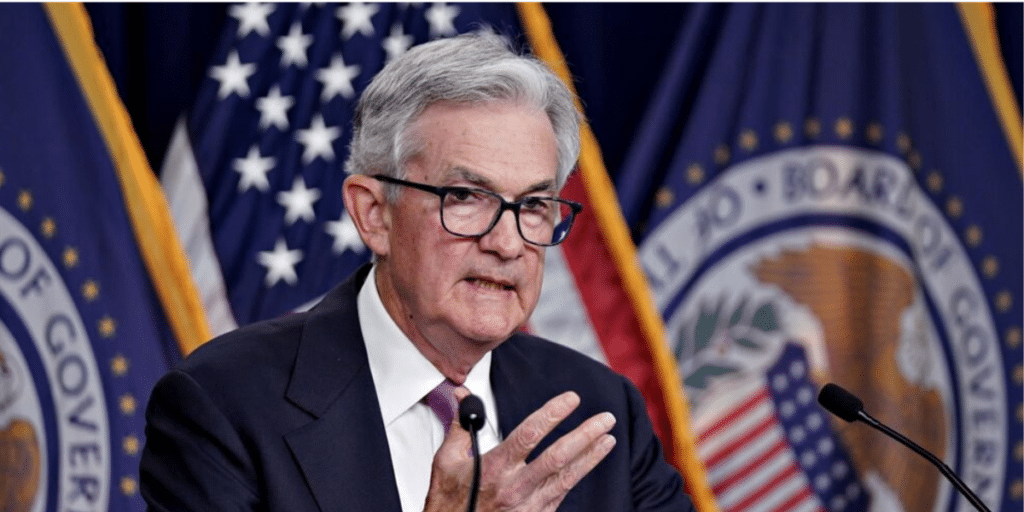
A Closer Look at the PCE Index
Recent statements from Federal Reserve officials suggest a cautious stance on interest rate cuts, with a growing consensus that reductions may not occur before June. This cautious approach is pivotal for gold investors, as higher interest rates diminish the attractiveness of non-yielding assets such as gold.
The Federal Reserve's meticulous balancing of inflationary pressures and economic growth concerns leaves investors speculating about the timing and extent of potential policy adjustments. With core CPI (excluding food and energy) remaining above the 4.6% mark and ticking higher this months data , inflation levels are still significantly elevated, complicating the Fed's ability to alter its current policy stance.
One contributing factor is the COVID-19 pandemic's impact on the employment market, which prompted the Fed to infuse unprecedented liquidity into the markets. Despite subsequent rate hikes, the economy continues to experience an excess of liquidity compared to historical norms. This surplus liquidity takes time to be absorbed by the economy, which explains why prices remain stubbornly high.
CPI index less Food and Energy since 2000
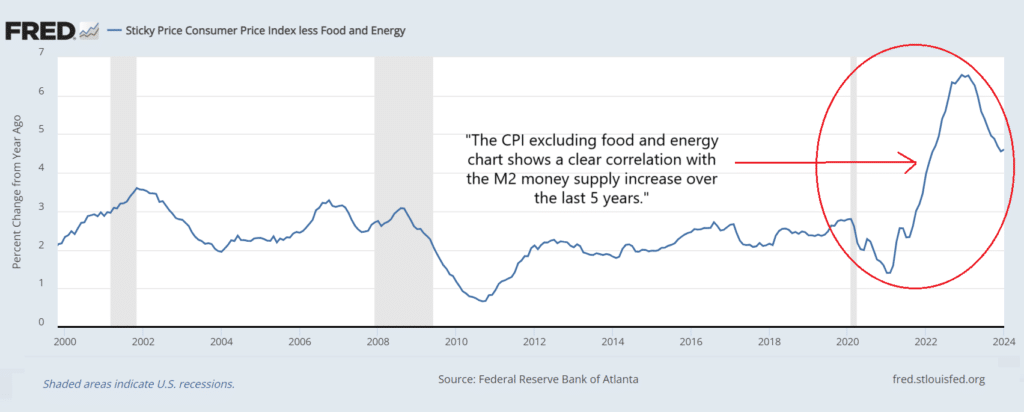
M2 Money Supply chart since 2000
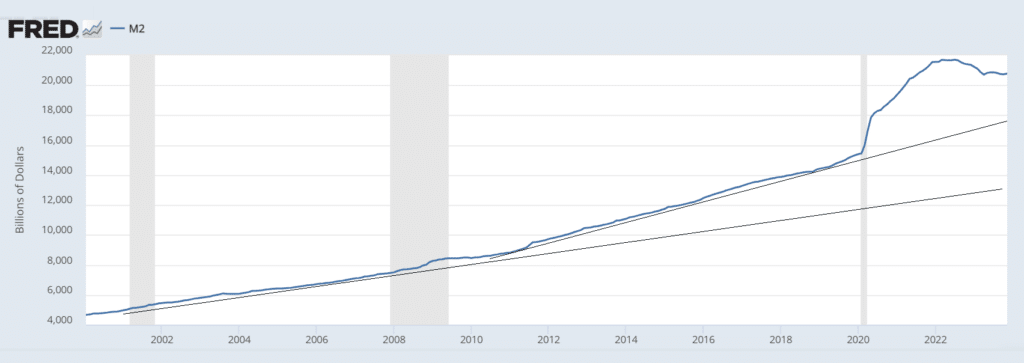
The comparison between the CPI index (excluding food and energy) and the M2 money supply chart clearly illustrates the influx of M2 money into the market over the last four years following the COVID-19 pandemic, and how the CPI index, less food and energy, subsequently adjusted to this influx. This visualization is pivotal as it succinctly conveys the overarching trend, offering a straightforward yet insightful view into the broader economic landscape.
Federal Reserve's Stance: A Key Factor
Recent comments from Federal Reserve officials indicate a cautious approach towards rate cuts, with expectations solidifying around the idea that reductions are unlikely before June. This stance is critical for gold investors, as higher interest rates typically erode the appeal of non-yielding assets like gold. However, the Fed's careful navigation of inflation and economic growth concerns keeps market participants on edge, pondering the timing and magnitude of any policy shifts.
Looking Ahead: Gold's Prospects Amid Inflationary Uncertainties
As we await the PCE data release, the intersection of inflation dynamics, Federal Reserve policies, and global economic factors will be crucial in shaping gold's path. Investors and analysts alike are keenly observing these developments, understanding that both the anticipation and the aftermath of such economic indicators can create ripples across financial markets.
1 year Expected Inflation chart last 10 years
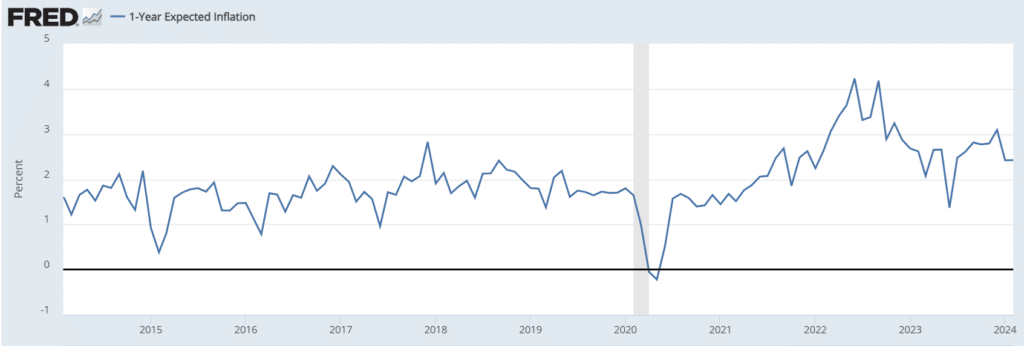
The upcoming PCE data is crucial, especially given the current high CPI ex-food and ex-energy prices, alongside rising crude oil prices to $80. These factors collectively influence inflation expectations in the market, which could potentially drive gold prices lower in the upcoming weeks. The direction of inflation trends, as highlighted by the PCE data before the next CPI and Federal Reserve meeting, will be a significant determinant of gold's price movement, influenced by both the actual data and its alignment with market expectations and Fed policy projections.
Conclusion
The correlation between the M2 money supply's expansion post-COVID-19 and the movements in the CPI index, excluding food and energy, highlights the profound impact of monetary policy on inflation trends. This dynamic underlines the critical need to understand monetary dynamics for analyzing inflationary pressures and their implications on the economy and financial markets. Therefore, the forthcoming PCE data will shed light on long-term economic trends, with gold serving as a crucial indicator of these dynamics.
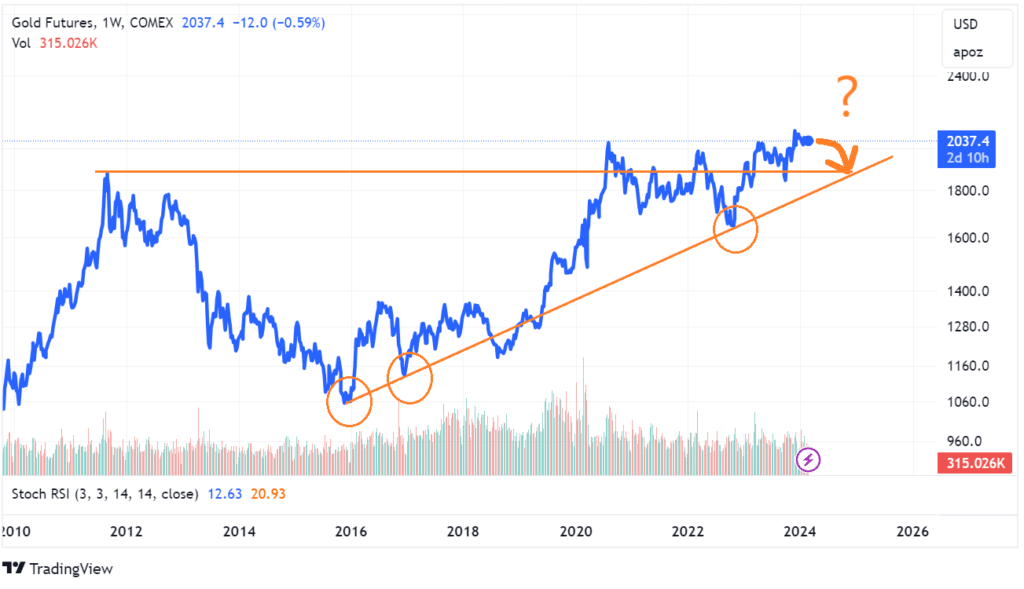
In conclusion, tomorrow's PCE data release is more than a routine update; it's a pivotal moment that could redefine market expectations regarding inflation expectations, interest rates, and the allure of gold as a strategic investment. As we navigate these uncertain waters, the interplay between hard data and market sentiment will undoubtedly influence investment strategies and market behavior.
Warm Regards
Sam Sacli
Editor
CONTACT US
The Scholarch LLC
1111B Governors Ave. STE 7059 Dover, DE 19904
research@thescholarch.com
Disclaimer: The Scholarch Reports upholds the highest standards of integrity and transparency in all its publications. We unequivocally assert that the content within our research articles is authentic and genuine, steadfastly adhering to the principles of impartiality and objectivity. Our commentary and analysis are conducted disinterestedly, devoid of any personal or financial interests that might potentially skew our evaluations. It is our policy not to invest in the stock ideas we report on. Should an exception arise, it will be clearly disclosed at the conclusion of our reports or articles. The insights and assessments provided in our research articles and reports are the culmination of meticulous research, intended solely for informational and educational purposes. They are not promotional in nature and should not be interpreted as an endorsement or solicitation to buy or sell any stocks, financial products, or services. The content provided on our website or in our reports does not constitute investment advice or an endorsement of any specific investment strategy. While we endeavor to provide accurate and up-to-date information, The Scholarch LLC and its affiliates do not guarantee its completeness or accuracy. We shall not be held accountable for any losses incurred from reliance on this information. Past performance is not a reliable indicator of future results. Readers are strongly advised to conduct their own due diligence and consult with a professional advisor before making any investment decisions. The Scholarch LLC does not possess a financial advisory license and therefore does not offer personalized financial advice. This website and our reports may include links to third-party websites and information; The Scholarch LLC is not liable for their content or accuracy. We appreciate your trust in The Scholarch Reports. Thank you for reading our disclaimer.

